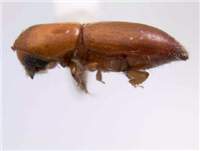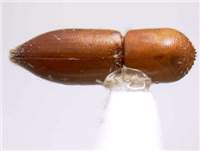Diagnosis
Elytra strongly tapering, pointed, scutellum either missing or minute, elytra often with visible mycangia near scutellum. Protibia slender protibia with rugose posterior side.
Similat to several Xyleborus with tapering elytra, but scutellum minute or missing, protibia narrow and inflated posteriad.
Distribution
Tropical Asia to New Guinea, possibly introduced to Australia.
Biology
Probably strictly specialized to Dipterocarpaceae. Galleries short, radial entrance tunnel and often large brood cavity.
Taxonomy
Possibly polyphyletic, species with obvious elytral mycangia do not group with others in a molecular phylogeny (Cognato et. al, 2010). Recently reviewed by Beaver & Hulcr (2008).
Detailed description
Eyes shallowly emarginate or almost entire, upper portion of eyes as large as lower part, or larger. Antennal club approximately circular, or appears broader than tall, club type four (segment 1 small, second and third prominent on both sides). Segment 1 of club small, convex, its margin mostly costate, may appear softer on posterior side, or mostly soft, pubescent. Segment 2 corneous on both sides of club. Segment 3 clearly visible on both sides of club. Segment 1 of antennal funicle shorter than pedicel, funicle 4-segmented, scapus regularly thick. Frons above epistoma mostly smooth, alutaceous, with minor punctures. Submentum slightly to deeply impressed, shaped as very narrow triangle. Anterior edge of pronotum with or without conspicuous row of serrations. Pronotum from lateral view with disc distinctly elongated (type 8), or long and "hooded" frontally (type A), or long, flat, inflated frontally (type B). From dorsal view it is conical on anterior part (type 6), or elongated basic shape with rounded frontal margin (type 7), or elongated and subquadrate (type 8). Pronotal disc shining or smoothly alutaceous, with small punctures, lateral edge of pronotum obliquely costate. Procoxae contiguous, prosternal posterocoxal process short and conical, or flat and inconspicuous. Pronotal basis without mesonotal mycangial tuft. All Cryptoxyleborus have elytral mycangia, but setae on elytral bases associated with them may be absent. Openings of elytral mycangia small or large, on anterior slope of elytral bases or upper surface of elytra, adjacent to scutellum. Scutellum visible on anterior slope of elytral bases. Elytral bases straight, with oblique edge, or curved, costate due to presence of elytral mycangium. Elytral disc longer than declivity, flat, punctures on elytral disc in strial lines (confused in some SE Asian species). Elytral declivity in all Cryptoxyleborus characteristically attenuated, apex pointed. Declivity with only few setae and no tubercles, but pointed apex often densely covered with minute setae and granules. First interstriae parallel. Protibiae are very slender, arcuate. Posterior side of protibia inflated and granulate. Protibial denticles small, bases of denticles not enlarged, fewer than 6 protibial denticles present. Metatibiae of normal size. Body length 1.9-3 mm. Uniformly yellow or light brown, rarely dark brown.


